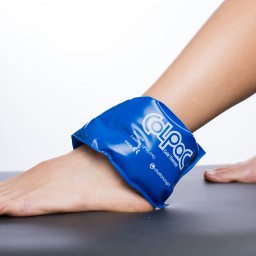SHOULD WE ICE STRAINS AND SPRAINS?
For years the RICE protocol (REST, ICE, COMPRESSION, ELEVATION) has been the gold standard for the management of acute injuries. When it comes to tendon and ligament strains I’ve always questioned this approach for several reasons.
The human body is remarkable. It is constantly growing, healing and regenerating cells and seems to do a pretty good job of it. Why then would you try to inhibit the natural processes that go into action as an immediate immune response to a trauma? A joint will swell as blood and fluids packed with inflammatory healing nutrients and cells are sent to the site of the injured tissue - and yet the first thing we do is administer ice and ibuprofen to reduce any inflammation. Surely this is counter intuitive?
Medical evidence and studies now back up the suggestion that it may not be the correct procedure to follow for certain injuries.
The ICE and REST elements of RICE may in fact impede rather than facilitate healing.
Ice as pain relief
As an analgesic, ice plays a role and does reduce the need for pain killing medication but as a vasoconstrictor limiting the blood supply it’s unhelpful. Ligaments, tendons and cartilage already have a limited blood supply compared to muscles and generally take longer to heal.
Following an injury, inflammatory mediators are released which cause vasodilation at the injury site. This widening of the blood vessels facilitates the supply of macrophages and leukocytes; white blood cells that are delivered to ‘clean up’ the area. In addition, the increased fluid supply may cause a swelling or edema which restricts movement and increases the response of the pain receptors in order to prevent us doing further damage. These are all natural, necessary reactions initiated to protect the area after the initial injury.

The body then sets about the process of its own anti-inflammatory response. The lymphatic system kicks in and removes the waste and excess fluid from the site, thereby reducing the swelling so the process of healing can begin. Excessive swelling is caused by inhibited lymphatic flow. It’s far easier to deliver blood to the site initially than it is to clear it away. This drainage system relies on muscular contraction. Rest and ice limit such contractions. Evidence suggests that elevation and compression are better options for facilitating this process.
This argument could also be extended to the use of NSAIDs post injury. Applying ice immediately after an injury will relieve the pain, but by continuing to ice more than 2-4 hours post injury you are restricting the body’s own inflammatory cytokines from doing their job.
Exercise
EXERCISE is underused in so many medical conditions, surprisingly not least in injury rehabilitation and recovery. Thankfully there is a gradual positive shift towards a new paradigm – MOVE – where the key to recovery is joint and muscle stimulation.
Movement.
Options for cross training.
Vary rehabilitation with strength, balance, agility exercises.
Easing back to activity early.
Correct exercise prescription is vital following an injury. Too much load and you’ll further damage the tissue; too little and recovery time is lengthened, strength diminishes, whilst muscle and surrounding tissue atrophies. A basic understanding of injury pathophysiology further supports the argument that rest is not the best option.
"As an analgesic, ice plays a role and does reduce the need for pain killing medication but as a vasoconstrictor limiting the blood supply it’s unhelpful. "
